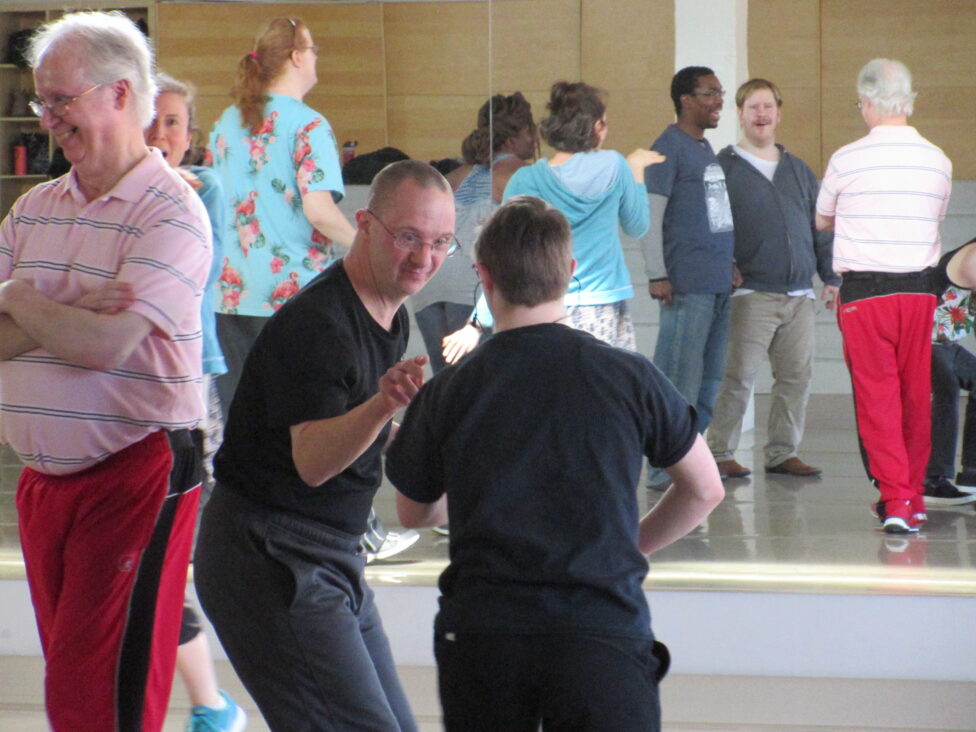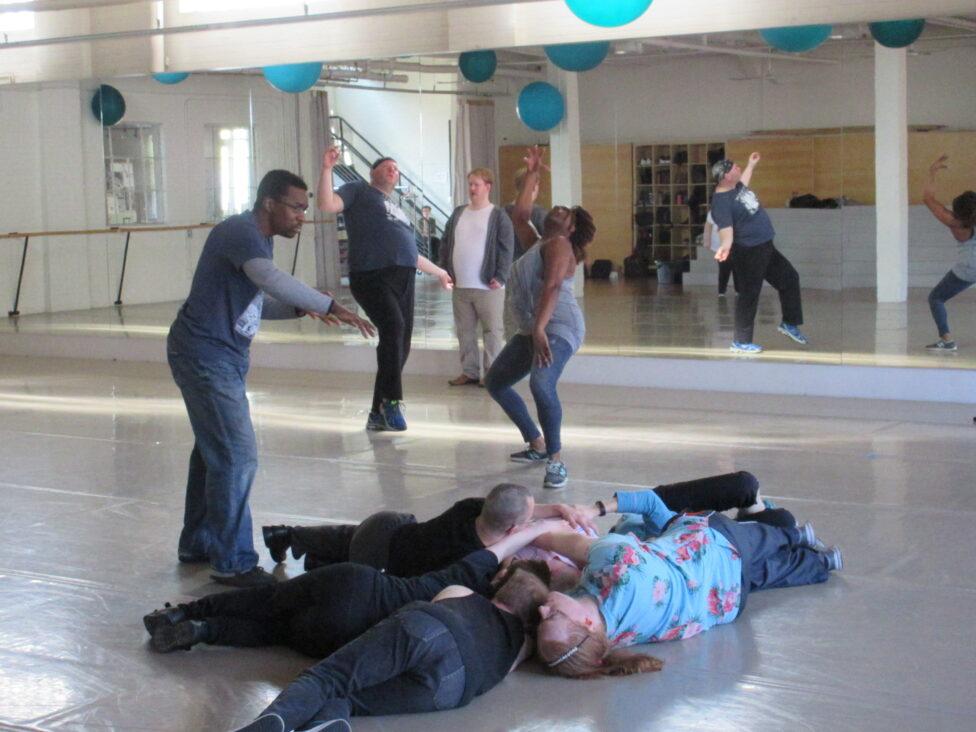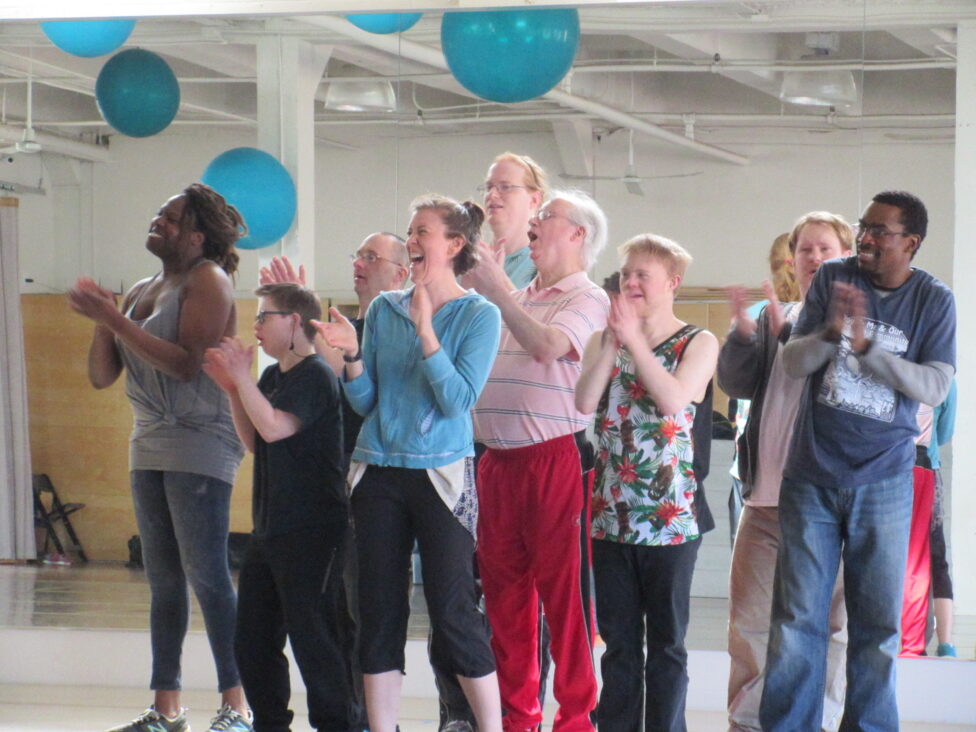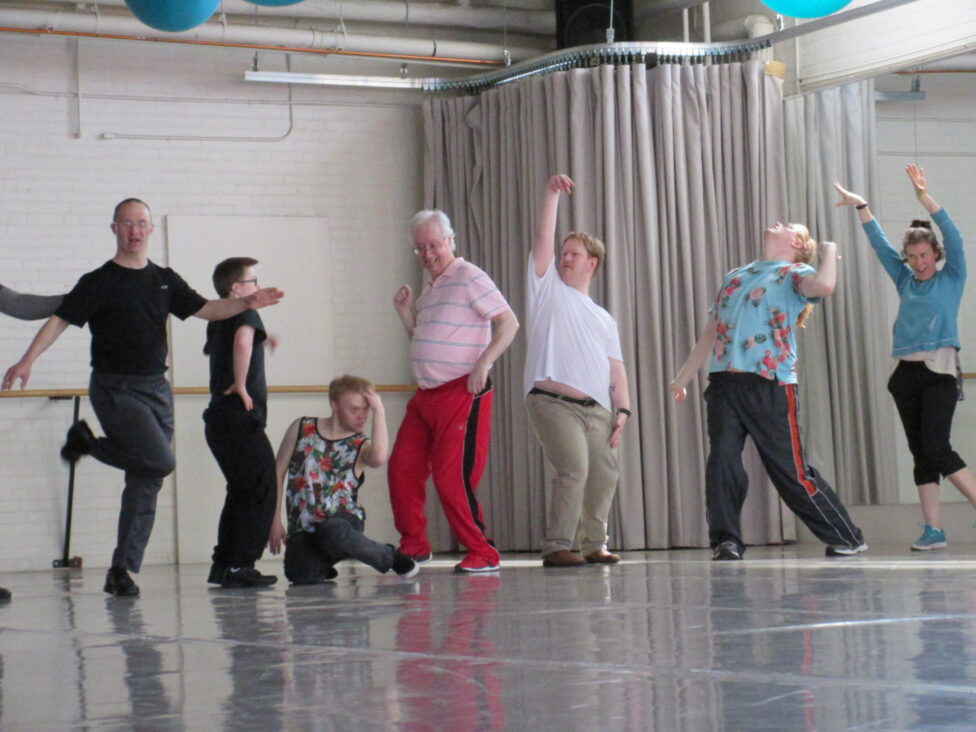Michael W
Beth Graczyk: So Michael, thanks for agreeing to be asked these questions. I was approached by a dance journal in New York around the relationships to touch right now, since there’s shelter in place, there’s social distancing, we are really changing our way of engaging with others. I was asked as a dance artist, how are my practices, or how are the practices of people that I’m engaged with changing or how have they been affected. In particular, I was interested in also hearing your response and ideas around the project that we’re engaged in, Here. Them. Now. in regard to touch. So, what is your relationship to touch in your daily life? Do you have any practices or approaches to communicating your needs around touch, to loved ones and strangers? And if so, what are they?
Michael W: Normally I didn’t go around touching other people, invading other people’s personal space, and I wouldn’t let anybody invade my personal space. But every once in a while I would get into a situation where I had to touch another person or where another person had to touch me. And if I ever got into that situation, I would have been fine with it. Like, if I was creating a piece with one of my fellow actors and there came a time where I had to have physical contact with them, then I would be okay with that.
Aaron Gabriel: Generally are you comfortable with physical contact with people or do you avoid it if you can?
MW: I avoid it. I avoid it when I am outside of Interact.
AG: Do you think that’s because of your personality or do you relate that back to your diversability?
MW: I think my personality has something to do with it. When it comes to somebody that I know, like my landlady or my associate landlady, Molly, or my dear friend, Todd Miller, who I’ve known a long time, then yeah. I would be exchanging hugs or handshakes with those people, but it’s like hugs and handshakes and stuff. When it comes to people that I don’t know, I usually don’t touch them.
BG: And has that relationship changed since shelter-in-place with regard to touch?
MW: [My landlords] Rosita, Molly, and I have not physically touched each other since the quarantine. I still go to see them whenever I have questions, but I don’t go inside anymore. It doesn’t make me feel good or bad. It’s just a thing that is, and I’ve managed to adapt to this country’s current situation really well. I mean, this world’s current situation.
BG: Can you tell us more about that?
MW: It’s made me more comfortable touching certain people and more aggressive in wanting to connect with those people. Because I have struggled with my sexuality for a long time. After I graduated high school, I started talking about how I felt towards the same sex and I knew that my family wouldn’t approve. I knew that my family wouldn’t like me being gay, especially my mom. Over the years I’ve gotten little by little more comfortable when it comes to touching certain people who have the same sexuality that I have. Our dance has given me confidence and that confidence has caused me to touch people who have the same sexuality that I have in a more aggressive way.
AG: What do you mean by aggressive? Do you mean in a more confident way?
MW: Yes.
AG: Okay. Just knowing you, I have a feeling what you mean is not, you’re not punching them. You’re more confident about touching and being, and since we’ve talked about this before, in initiating touch or asking for touch?
MW: Yeah, that’s what I mean. The dance has given me more confidence when it comes to touching other people.
AG: I was wondering if there was if there’s one particular “choreographic idea” that Beth gave you that was particularly helpful or challenging when it comes to touch, she calls it a choreographic idea–
MW: Yeah, not really. Due to my Autism, my Asperger’s Syndrome or whatever you want to call it, sometimes it takes me a minute to comprehend what the task is. I have to see a task performed before I am able to perform the task myself, comfortably and with confidence. Sometimes, I don’t have to see it. Sometimes all you have to do is say what I have to do, and I’ll be able to do it.
AG: What was it like to do your solo in the dance?
MW: Every time I do my solo dance and the song that I’ve added, I’m always more and more confident. And I like, I like how it changes. I like how some of the advice that you and Beth give me changes the dance because of how I do a movement. I sing. I do another movement. I sing. I do another movement. I sing. Because the dance that I am performing, you can’t really dance and sing at the same time. One part takes away from the other parts.
AG: Well, it’s very active.
MW: Yeah, it is.
BG: Watching you [in rehearsals] you’ve become really good at that task where we press into each other and give each other weight, or we move away and counter balance. And I feel like you in particular, really shine in that physicality of touch. And I wonder if that felt natural to you, or if that felt like a process that you had to see it in order to do it?
MW: It all depends on who I’m paired with, right? So when I am doing the back-to-back thing with another dancer, sometimes I have to link arms with the other dancers so that I’m evenly matched and then my back leans into their back, but I can’t lean into my back too much, otherwise too much pressure will put them off balance. If they go off balance, we end up falling. So it’s up to me.
It really is up to me how much weight I have to give! So that the other person’s body is supporting me and I am supporting the other person’s body. When we are pressing against each other’s hands, that is easier because we’re just leaning forward and I can control the amount of weight that I put on the other person. They control the amount of weight that they put on me, but it’s leaning on each other’s backs is the difficult thing.
BG: Well, it’s also less common of an action. But you’re also saying something that’s very dynamic in touch-based relationships too where it’s dynamic by nature. You give a little, you see how that person responds and then you-
MW: And then I adjust myself according to the person that I’m dancing with.
BG: Right.
MW: And even advice that [another Interact dancer] Kymani gives: I can’t just make an action just for the sake of making an action. I actually have to think about the action that I make and whether or not my action is necessary. I have to think about whether or not my action is contributing to the performing art that we’re creating, or if it’s taking away. Or am I doing a certain action just for the sake of doing that action.
BG: Right. Which is even more important when you’re engaging with weight sharing. Cause if you’re not paying attention or if you do an action and you let go of that person or they fall or you fall, so it has more immediacy too.
MW: I try not to let anybody fall. When I’m with [fellow dancer] Suzy, for example, every time that I feel one of us beginning to fall, I buckle and I stand back up before the fall happens so that Suzy doesn’t get hurt or I don’t get hurt.
BG: You’re being responsive to the moments.
MW: Yeah.

photo by James Lekatz
ID: two dancers in a studio facing each other in the foreground, while other dancers are reflected in the studio mirror behind them
Daniel M
Beth Graczyk: So, Daniel, we’re going to start with a broad question. What is your relationship to touch in your daily life? Do you have any practices or approaches to communicating your needs around touch to loved ones and strangers? And if so what are they?
Aaron Gabriel: And also think before the pandemic.
Daniel M: So during the pandemic, excuse me, current pandemic, I noticed that I really wanna give hugs or high fives or fist bumps. And because of social distancing and possible transference (I don’t know what the proper term for that is), but I am unable to do that. In general, touch, because it’s one of our five senses, sometimes it feels like that sense is currently lost. If that makes sense.
Yeah. It’s like I tell my mom every few days, I miss your hugs. Cause I miss high fives, I miss — I don’t know if this is the right word, but intimacy or feeling of being in contact with another person physically. Before the pandemic I was a little wary because even though I’m not the best at reading social cues and knowing boundaries, sometimes I would feel, what’s the right word, I don’t want to say reluctant cause that’s not the right word, but…
BG: Careful?
DM: Thank you. Careful to touch another person. Of course I would always, and I still do ask is it alright if I do this? Is it alright if I do that? Especially, for example, around animals. Let’s say a neighbor’s dog comes up to say hi. I’ll ask: “I like your dog. Is it alright if I pet your dog or cat or what have you?”
BG: Do you have anybody right now that you can receive physical touch from or interact, or are you entirely isolated in terms of no touch?
DM: I suppose a little bit of both. I mean maybe small forms of touch would be acceptable. I can give high fives or fist bumps, but as far as a full on hug then that’s sort of discouraged. But smaller things, again like the high five or the fistbump.
AG: You’re in a group home, right. Daniel?
DM: Correct.
AG: So with your people in your group home can you give a high five or fist bump?
DM: Yes.
AG: Cause it’s a limited contact space.
DM: Yeah. But then there are air contacts: air fives or air fist bumps or air hugs. But while the air interactions are available, I miss the physical content.
BG: So you’re looking for that memory of the connection and making a connection, which I can imagine it’s not the same as direct touch, but it is giving you something.
DM: Yeah, absolutely.
BG: For our project, Here. Then. Now., from the beginning of the process to where we are now, I’m curious if you could describe how your relationship to touch has changed over the course of the project and if there were practices that were more difficult or challenging, or really opened you up in some way? Anything that you want to speak about in relationship to touch?
DM: I would say well, for example, the “weigh in weigh out” [weight exchange exercise] segments, that can be very opening. It can also make a person very vulnerable, if I can use that term. But not in the sense of weak vulnerability, more like being open and presenting. Or the “push and pull” as well. You know, that’s kind of similar because when you’re pushing, you can have that connection. And the good thing about that, similar to the air five and the air first bump, you can do it while social distancing. You don’t have to be in direct contact. But it’s still contact, just like one of my coworkers says, “from a distance.”
AG: Some of the artists before the pandemic would say, “high five from a distance” or “fist bump from a distance” just to not pass so many germs. It’s like a school in some ways, like there’s so many people coming in from group homes and different environments where they live with people who have compromised immune systems.
We had to practice some of that stuff even before. I guess, when I think about it, we’ve practiced a lot of that at Interact because of the environment that we work in with people who are vulnerable. We have to take extra precautions.
DM: That’s true. Yeah, we do.
BG: Yeah, I just have one more, one more thought. One thing I really admire about your movement sensibility is that I feel that you really sense with your skin and with your own vision of how you’re perceiving the space. And it feels like you’re really able to track, track movements in a different way, in ways that other people can’t. Which makes it really exciting to have you in a group because you’re able to respond more to the energy than visual queuing and I’m wondering if you could describe a little bit of that experience internally.
DM: Yeah sure. Because I have limited vision I’m not always able to pick up social cues or smaller body signals. Over the years I taught myself, as you’ve said, to feel the energy around me and to sort of trust my feelings. It’s going to sound kind of geeky, but in a way it’s kind of like the idea of the force in Star Wars.
BG: That’s great! Yeah, that seems like an accurate metaphor.
DM: Everything gives off energy and we, humans, give off our own energy and we’re able to interact with everything around us.
AG: Going back to this idea of sensing, there’s a section in [Here. Them. Now.] where you do quick movements between people’s slower, more methodic movements. And with your limited vision and you’re moving through them, I don’t think you’ve ever, ever collided with anybody.
DM: There was maybe one time, but that’s cause we were still new at it and we’re trying stuff out and then it’s like, oh, okay, that doesn’t work there!
AG: It’s just an interesting thought. You’re aware of people’s space and aware of their physicality. And even with limited vision, you can really be bold in your movements and not collide with everybody if you’re aware, or even more sensitive, even more aware.
DM: Well, for me, one thing that really helps is sound. If there’s a movement and a sound. And depending on where it is, I can crack the sound and know it’s coming from my left or is coming from down the hall or — I’m trying to remember what James called it. That sort of sort of active neutral, where you’re engaged, but it’s not like everyone hurry up and run kind of engaged.
AG: Active, neutral, I think that’s right.
DM: Yeah. Sorry. I might be misquoting that, but-
AG: I think that’s correct. I mean, there’s so many terms for that, depending on what practice you come from.
BG: That resonates with how you’re describing that in those collections. Active, neutral. That then makes sense.
DM: Or let me rephrase that. Being, being, present.
AG: Being engaged, even though you’re not doing anything.
BG: Yeah.
DM: Yeah.
AG: I think that is active, neutral?
BG: Yeah, Daniel, that is definitely something I really, really admire in you is that you can be on stage for a very long time or you can be in a position for a very long time and still be very engaged and engaging because of that quality that you have. So that it’s so exciting to hear you articulate that.

photo by James Lekatz
ID: a group of dancers embracing on the floor of a dance studio while one dancer stands over them and three dancers move behind them
Jule M
Beth Graczyk: So Jule, what is your relationship to touch in your daily life? Do you have any practices or approaches to communicating your needs around touch to loved ones and strangers? If so, what are they?
Jule M: I usually don’t touch people I don’t know well. Because I know about boundaries. I’ve been taking karate a lot. I [learned] to use my self-defense. They have me learn about when it is okay and when it is not okay to touch.
BG: I’m curious for our project Here. Them. Now., if you could talk a little bit about how your relationship to touch has changed over the course of the project? From the beginning workshops through the development of the piece.
JM: I’m remembering my solo because – as I said – I was taking karate. I learned how it makes me feel like a man and I like to do manly stuff, like karate. Also I like to dance.
BG: Ya, yes. Let’s talk more about your solo. I’d love to know more about this idea of karate and this kind of masculine energy that you really want to bring forward and yet you’re wearing this very particular piece that’s crocheted of these heavy breasts. [During your solo] you go through this very physically rigorous physical process where you are grunting and trying to break through the different forms the ensemble makes like a cluster or a wall. I wonder if you could talk a little more about that process for you.
JM: I have a feeling of energy when trying to push myself through the wall. Pushing my body makes me shake a lot. I can feel the touch I get from touching my fellow coworkers and it feels like I’m breaking through a hard rock.
BG: Like, through the cluster of the actors?
JM: Yeah, cause it feels like I’m stuck in mud when I feel that push in my solo. It feels exciting when I get my energy going when I begin like that. When I get serious and my face also turns serious to focus on what I’m doing when I’m beginning to try to [break through the wall the ensemble created]. I feel moved when I’m alone during my solo and I feel a lot of power with my arms but I get mixed feelings.
AG: I think it’s nice to hear you say that sometimes through pushing against somebody, you can understand yourself better. Yeah. Really interesting way to look at something. Sometimes you need to push and have some force against you to get to know yourself a little better. I’m wondering Jule, outside of your solo, were there activities where you felt a connection through touch with some of the other different choreography Beth gave us or some of the different exercises?
JM: I felt connected to touch when I was partnered up with Heather Bunch. We engaged in…I don’t know what the name is…
BG: The touch tag?
JM: Yes, touch tag! It’s kind of like a game and it feels like we’re playing together, but we have to get our body going and it makes me feel kind of loved and that I’m always connected to her. With the group, we would touch by making a shape with our body. With them I feel loved and that I’m staying active, staying with magic cause I know that I’m connected with my fellow coworkers who help me grow. We are here together.
BG: Yeah, I’m so glad you’re describing that moment. It’s an ensemble group effort through touch that builds together through physical interaction. I love that you feel that inside of doing it because as an audience, we see that, but from the inside that you feel connected and that you can feel the whole is really wonderful.
JM: Thank you, Beth.

photo by James Lekatz
ID: a group of 10 people applauding and smiling





